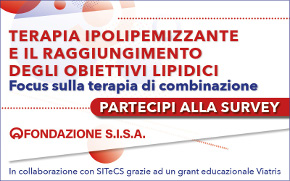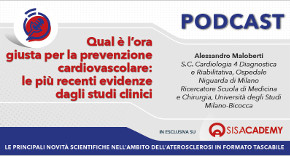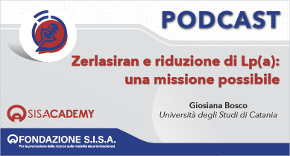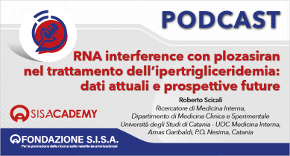 Rivista in lingua italiana
Rivista in lingua italiana
riservata ai Soci SISA
Ultimo numero:
Anno 16 • N.1/2025
SISANews
Non ci si deve accontentare della terapia con alte dosi di statine. Bisogna guardare il livello di LDL che si raggiunge
Molti studi hanno ormai dimostrato che raggiungere livelli di colesterolo LDL molto bassi significa ottenere un maggiore beneficio in termini di risparmio di eventi cardiovascolari. Le linee guida europee indicano come valore obiettivo per il colesterolo LDL un livello inferiore ai 70 mg/dL per i soggetti a rischio molto alto, ma alla luce degli studi più recenti questo valore appare un po' troppo conservativo. Le ultime linee guida americane raccomandano l'uso di statine ad alta o moderata efficacia a seconda del livello di rischio globale, senza peraltro indicare un obiettivo terapeutico. Ma la risposta individuale alla terapia con statine è piuttosto variabile e scarsamente prevedibile. Nella meta-analisi di Boekholdt e coll. emerge chiaramente, come era previsto, che quello che conta è il livello di colesterolo LDL che si raggiunge in corso di terapia. Tanto più è basso, tanto maggiore è il beneficio che ci si può attendere. La dose di statine va dunque modulata sulla risposta ottenuta.
![]()
Very low levels of atherogenic lipoproteins and the risk for cardiovascular events: a meta-analysis of statin trials.
Boekholdt SM, Hovingh GK, Mora S, Arsenault BJ, Amarenco P, Pedersen TR, LaRosa JC, Waters DD, DeMicco DA, Simes RJ, Keech AC, Colquhoun D, Hitman GA, Betteridge DJ, Clearfield MB, Downs JR, Colhoun HM, Gotto AM Jr, Ridker PM, Grundy SM, Kastelein JJ
J Am Coll Cardiol 2014;64:485-494
BACKGROUND: Levels of atherogenic lipoproteins achieved with statin therapy are highly variable, but the consequence of this variability for cardiovascular disease risk is not well-documented.
OBJECTIVES: The aim of this meta-analysis was to evaluate: 1) the interindividual variability of reductions in low-density lipoprotein cholesterol (LDL-C), non-high-density lipoprotein cholesterol (non-HDL-C), or apolipoprotein B (apoB) levels achieved with statin therapy; 2) the proportion of patients not reaching guideline-recommended lipid levels on high-dose statin therapy; and 3) the association between very low levels of atherogenic lipoproteins achieved with statin therapy and cardiovascular disease risk.
METHODS: This meta-analysis used individual patient data from 8 randomized controlled statin trials, in which conventional lipids and apolipoproteins were determined in all study participants at baseline and at 1-year follow-up.
RESULTS: Among 38,153 patients allocated to statin therapy, a total of 6,286 major cardiovascular events occurred in 5,387 study participants during follow-up. There was large interindividual variability in the reductions of LDL-C, non-HDL-C, and apoB achieved with a fixed statin dose. More than 40% of trial participants assigned to high-dose statin therapy did not reach an LDL-C target <70 mg/dl. Compared with patients who achieved an LDL-C >175 mg/dl, those who reached an LDL-C 75 to <100 mg/dl, 50 to <75 mg/dl, and <50 mg/dl had adjusted hazard ratios for major cardiovascular events of 0.56 (95% confidence interval [CI]: 0.46 to 0.67), 0.51 (95% CI: 0.42 to 0.62), and 0.44 (95% CI: 0.35 to 0.55), respectively. Similar associations were observed for non-HDL-C and apoB.
CONCLUSIONS: The reductions of LDL-C, non-HDL-C, and apoB levels achieved with statin therapy displayed large interindividual variation. Among trial participants treated with high-dose statin therapy, >40% did not reach an LDL-C target <70 mg/dl. Patients who achieve very low LDL-C levels have a lower risk for major cardiovascular events than do those achieving moderately low levels.

Area Soci
Eventi
39° Congresso Nazionale
 39° Congresso Nazionale
39° Congresso NazionaleRoma, 23-25 novembre 2025
Save the date




 Spring Meeting Gruppi Giovani SID, SIGG, SIIA, SIMI, SIPREC, SISA
Spring Meeting Gruppi Giovani SID, SIGG, SIIA, SIMI, SIPREC, SISARimini, 6-8 aprile 2025
[continua a leggere]
 SISA LIPID ACADEMY - Corso avanzato di lipidologia clinica
SISA LIPID ACADEMY - Corso avanzato di lipidologia clinicaModena, 4-5 Luglio 2024
[continua a leggere]Giornale Italiano Arteriosclerosi
HoFH today
 Rivista Italiana della
Rivista Italiana della
Ipercolesterolemia
Familiare Omozigote
Anno 6 • N.1/2024
Rivista NMCD
Diateca
[continua a leggere]
[continua a leggere]
Newsletter
il vostro indirizzo di posta elettronica
Progetto LIPIGEN

Nuovo sito dedicato al Progetto LIPIGEN
Progetto LIPIGEN - Vecchio portale
E' necessario essere loggati come utente
Lipigen per poter accedere alla pagina
PROject Statin Intolerance SISA
PROSISA – PROject Statin Intolerance SISA
E' necessario essere loggati come utente
PROSISA per poter accedere alla pagina
GILA - Lipoprotein Aferesi
Gruppo Interdisciplinare Lipoprotein Aferesi
(Accesso Gruppo GILA-Lipoprotein Aferesi)
E' necessario essere loggati come utente del Gruppo GILA per poter accedere
Gruppo Interdisciplinare Lipoprotein Aferesi
(Documentazione ad accesso libero)
Pagina informativa per medici e pazienti










